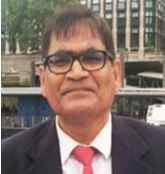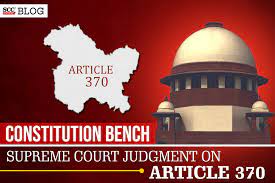 Professor Satya Narayan Misra in Bhubaneswar, December 14, 2023: When on 5th August 2019, the Modi government decided that Article 370 shall ‘cease to be operative ‘in terms of Presidential Powers to do so and convert the State into UTs, there were understandable outcries that’ it was a fraud on the people of J& K” (Anuradha Bhasin) to Pratap Bhanu Mehta calling it a new form of repression’ reminiscent of the Reichstag constitutional ideology that sees federalism as an obstacle to a strong state and homogenous culture.
Professor Satya Narayan Misra in Bhubaneswar, December 14, 2023: When on 5th August 2019, the Modi government decided that Article 370 shall ‘cease to be operative ‘in terms of Presidential Powers to do so and convert the State into UTs, there were understandable outcries that’ it was a fraud on the people of J& K” (Anuradha Bhasin) to Pratap Bhanu Mehta calling it a new form of repression’ reminiscent of the Reichstag constitutional ideology that sees federalism as an obstacle to a strong state and homogenous culture.
However, there was a sense of relief that the special status of J& K had outlived its necessity. The Supreme Court decision that J&K does not have any internal sovereignty after it accedes to the Indian Union and that the Presidential order of 2019 was within the ambit of Article 370(3) has left a lot of questions unanswered. Since Article 370 is a vexatious construct, a brief delineation to demystify it is in order. Article 370(1) limits the power of the Parliament to make laws for the state of J&K in respect of matters in the Union List and Concurrent List.
However, the special status under 370 was hollowed out after the arrest of Sheikh Abdullah in 1953 and the Presidential Order of 1954. 94 out of 97 entries in the Union List, seven out of the 12 schedules of the Indian Constitution were extended to the state before 370 was abrogated in August 2019. As Gulzarilal Nanda, former Home Minister observed in 1964:’ Article 370 is neither a wall but it is a tunnel. It is through this tunnel that a good deal of traffic has already passed and more will. Little did Nanda realize that Modi would make it a national highway and extinguish the hollow shell of 370!
But the real subterfuge of the government is to interpret Article 367, where it has used the governor’s assent as a substitute for a recommendation by the State Assembly to extinguish 370. As per Article 370(3), the President can abrogate 370 based on the recommendation of the J&K Constituent assembly. Since the Constituent Assembly is no longer in existence, the sane interpretation was that a duly elected State assembly can only recommend such abrogation.
It is indeed a travesty of constitutional morality that the Governor who is a representative of the Central government was used as a tool to legalize the process. For CJI Chandrachud to affirm that the presidential order is not mala fide is not only a travesty of federalism, which is a basic structure but of constitutional morality which he frequently parrots. The saving grace of the judgment is the resuscitation of J& K as a state and vindication of Article 3 which permits the creation of new states and alteration of boundaries but does not permit down gradation of state into UTs.
The Solicitor General, sensing a clear violation of Article 3, had assured the Court of the government’s intention to restore the status quo of J& K as a state. The Court merely noted the government’s change of stand. Sadly, it has acted squeamish and diplomatic in not pronouncing its authoritative ruling that the Constitution does not permit the conversion of the state as UT as the rule of Centre by proxy. The perception that the Supreme Court will not like to admonish constitutional malfeasance by the Modi government and can be complicit has been bolstered by this judgment.
 India cannot become a ‘union of union territories.’ The Kashmiris believe that Article 370 has made them an autonomous part of India and now they are occupied. For supporters of Azadi, it is a moment of Schadenfreude. Both kinds of opinions understand that the destruction of the compact of J& K signals the beginning of their disempowerment and marginalization. Citizens and their rights are pivotal to the health of a liberal democracy.
India cannot become a ‘union of union territories.’ The Kashmiris believe that Article 370 has made them an autonomous part of India and now they are occupied. For supporters of Azadi, it is a moment of Schadenfreude. Both kinds of opinions understand that the destruction of the compact of J& K signals the beginning of their disempowerment and marginalization. Citizens and their rights are pivotal to the health of a liberal democracy.
While a perception is being created that people of J&K are being integrated, they have been alienated more and more since 5th August. With the Supreme Court upholding the abrogation of 370, they feel demoted and disenfranchised not just politically but as citizens, with their civil liberties in tatters, not just through military repression but also endangering fears of a demographic alteration locally.
Equally worrying is the new strategy to maintain a sophisticated system of surveillance in Kashmir that is seen as impinging on the civil liberties of the people compelling Sumanta Sen to draw a comparison between India’s handling of Kashmir with the Chinese model of assimilating rebellious Muslims into a form of national identity in Xinjiang.
India’s Kashmir narrative as curated by the Indian government and its loyalist media pumps up the majoritarian Hindu contempt for Muslims and Kashmiris. The new India projected as strong and united is being envisioned not by inclusion but by exclusion of its people through laws like the Citizenship Amendment Act and National Register of Citizens. At present Kashmir throbs with a pervasive silence.
The silence is not only from fear but also from the knowledge that Kashmiris are pitted against cultural homogenization and waiting for the avalanche to subside. Prof Noor Ahmad of Central University of Kashmir warns that the existing and defining mood of despair and fear in the valley has the potential of radicalizing some sections of Kashmiri society.
In January 2020, India’s first CDS came up with the pernicious idea of setting up deradicalization camps for Muslim minors and teenagers in Kashmir. The remarks militate against the constitutional spirit of secularism and equality and the justice system that constitutional democracy offers in India. The Supreme Court’s judgment has nullified that hope of judicial neutrality. As Montesquieu wrote, “There is no greater tyranny than that which is perpetrated under the shield of law and in the name of justice.”
Prof Misra teaches Constitutional Law



Leave a Reply
Be the First to Comment!